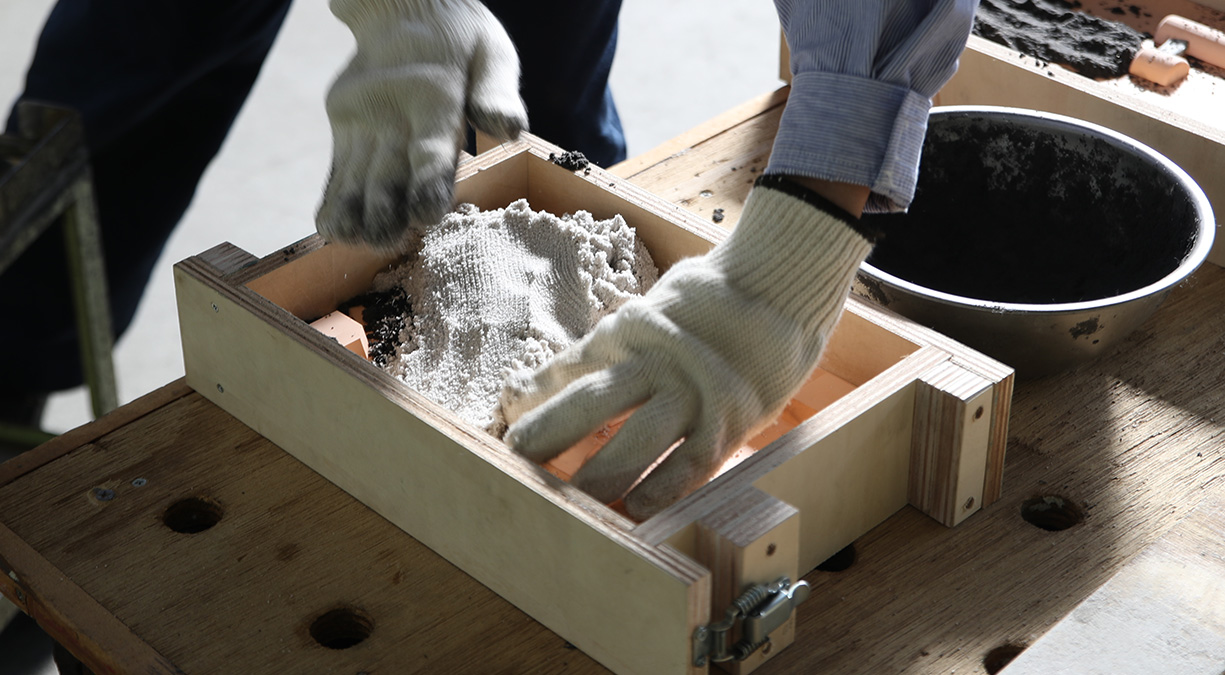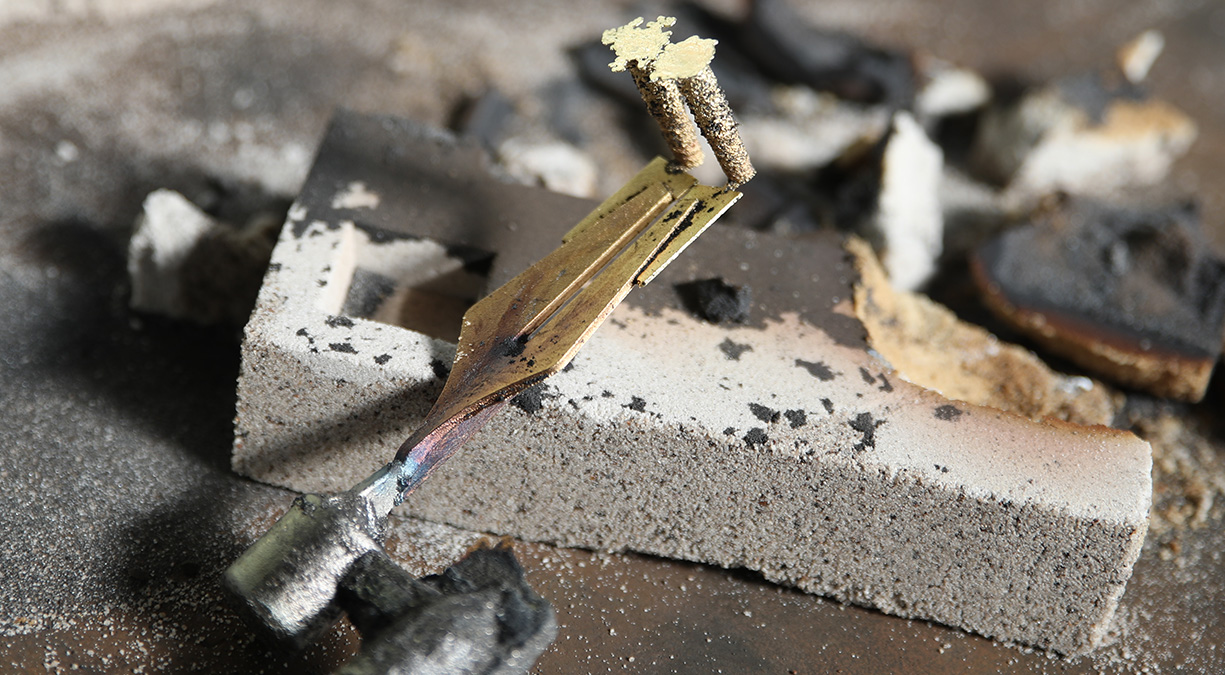Yamaha Motor’s first product was the YA-1 125cc motorcycle released in 1955, and on the front fender of this historic vehicle stood a handsome brass ornament shaped like a tuning fork. The craftsmen at Yamaha Motor’s prototyping departments and workshops took center stage in creating a special limited reproduction of this piece of our history.

Just Getting Started Is a Challenge
With its heavy weight and golden luster, brass—an alloy of copper and zinc—has a unique look and feel not found in other metals. The passage of time imbues it with a new appearance, a richer and darker hue. Brass is also a pleasure to polish, for when brought to a beautiful mirror finish, it is a joy to behold.
However, casting with brass is a much more time-consuming process than casting with other metals. Although people have been working this material for more than 350 years, there has been surprisingly little innovation in the technology and techniques for its production over that time. Brass metalworking has lasted to the current day as a culmination of the experience, knowledge, and handwork of countless craftsmen passed down over the centuries.
One of the challenging characteristics of brass is its high melting point. While aluminum melts at about 660°C, brass requires between 900°C to over 1,000°C to melt, depending on the type. “Before we can even get to actually casting something, it’s difficult enough just to get a furnace hot enough for brass to begin with,” admits one engineer. The general uses for brass are also somewhat limited, making it difficult to project the development of future equipment and techniques. But Yamaha Motor has been making brass castings in-house as far back as the 1950s.
The task to faithfully reproduce the front fender ornament originally made for the YA-1 in 1955 was delegated to Yamaha Motor’s prototyping department. The prototyping factory performs two critically important functions in Yamaha’s Monozukuri operations. The first is producing prototype parts for R&D, while the second is making prototypes to prepare for mass production during product development. To accomplish this, the veteran craftsmen here have a plethora of materials, machining techniques, and manufacturing equipment at their disposal, together with the company’s deep well of knowledge and experience as well as their own wholehearted dedication to quality craftsmanship.

Staying Faithful to the Original
The first thing they did was carefully examine the original ornament in their hands, its color tarnished by age. If it was simply to reproduce the shape alone, they were fairly confident they had the know-how to make it happen. However, the prototyping craftsmen wanted to take this job a step further: “We wanted to make the ornament with the same methods used 68 years ago. By going through the same process of trial and error our predecessors did, we believed we could experience some of the difficulties and thoughts they must have felt back then.”
The first step was to identify the composition of the brass used for the ornament. As with other metals, “brass” is a general term. Depending on the percentage of copper and zinc in its composition, not only does the color change, but so do its properties for elongation, strength, and more. Based on examinations of the original and the hypothesis of its manufacturing process, the engineer charged with the task surmised that the ornament was made of HBsC1 (JIS standard), a high-strength casting brass. And in fact, they later discovered a memo on the design drawing that confirmed this supposition. When he found “HBsC1” handwritten on the drawing, he gleefully shouted, “I knew it!”
Their next task was to determine the original’s manufacturing method. Over the three years they were made, approximately 11,000 YA-1s were completed and shipped. From this figure, the engineers extrapolated an average daily production number and presumed that the ornaments were likely cast in sand molds prepared by hand. Because sand has a low specific heat and retains heat very well, molten material cools slowly when it flows into the mold.
While this is the most traditional of casting methods, it is still commonly used today for small-lot production. As a result, there is extensive knowledge on hand regarding this method.
The engineers’ final box to tick was the casting design. In essence, this is a design drawing for the casting work and equipment, and compiles all the specs and specifics for creating the workpiece, such as the gating system, melt temperature, etc. They had to determine where and how to pour the molten material into the mold to ensure that it would flow into every nook and cranny of the mold correctly. After a number of failed attempts, they found a solution that worked and felt that “this is probably how they did it.” Of course, since they couldn’t find any records of the original casting plan, they couldn’t be completely certain, but they thought that the pioneers behind Yamaha’s first motorcycle would not find fault with their efforts. After making repeated test castings, the prototype team eventually finalized a method for successfully casting the ornament.
Seeing the casting process unfold was like turning the clock back 68 years to the day.
The first step was to place the separate upper and lower wooden patterns into the mold. To compensate for the shrinkage that occurs when the molten material solidifies, the mold is made slightly larger than the product’s final dimensions. Three different types of sand are then packed into the mold in sequence. The sand is compressed by hand for delicate control of the pressure applied, softly packing it in some spots and tightly in others. The use of different grades of sand is to bring the surface texture of the replica closer to that of the original.
The parting line between the two halves of the mold is carefully flattened by hand. After the sand has hardened and dried, the top and bottom halves are joined. Although very tightly compressed, the mating surface is still sand, so if the mold is handled roughly, the sand can collapse and fall into the runner, ruining the surface of the casting. When part of the tightly sealed mold is cut open, it reveals the small sprue for the melt, something that took numerous trials to finalize in the casting design.

Envisioning the Temps, Speeds, and Volume Required
With the mold ready, it’s time to prepare the brass. Inside the crucible, the brass is already in a liquid state and glowing red-hot, a clear indicator that it is breaking past the 1,000°C mark. Inside the crucible is yet another smaller crucible that functions as a ladle. In cooking terms, it’s like having an oven inside another oven. The operator carefully monitors the progress of these preliminary processes and brings the melt to the desired temperature.
At this critical moment, timing is everything. Using a pair of foundry tongs, he firmly grasps the small crucible from inside the main one and pours the molten brass into the pouring spout. It takes only one or two seconds, but in his mind’s eye he can visualize the melt flowing down the sprue and through the runner at the right speed to fill the mold cavity. The temperature, speed, and volume must all be correct or the melt will misrun, meaning the mold won’t fill properly and the casting will be defective. The craftsman got the right timing and feel down over the many test castings the team conducted.
After the mold cools, it is taken apart and the freshly cast piece is removed. The unneeded parts leftover from the casting design are cut away to reveal the proud tuning fork ornament. Now the detailed machining and finishing work begins. The ornament is progressively polished with seven different variations of sandpaper, from coarse #180 grit to microfine #2,000 grit, ending with a final polish on a buffing machine. Approximately one hour is needed to polish a single ornament today, so the original craftsmen must have spent at least that much time polishing the ornaments they made in the ‘50s.
“We wanted to faithfully recreate the original ornament using the same materials, casting method, and finish. We pooled and applied our knowledge to the task and it took much trial and error to succeed. But to recreate this iconic brass ornament experiencing the same things our predecessors did was a valuable experience.”
ー
“We wanted to make the ornament using the same methods used 68 years ago.” Spurred on by this goal, what the craftsmen gained from this journey into the past was a newfound respect for their predecessors and the unfiltered joy from being completely absorbed in the Monozukuri process.





